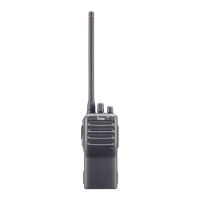
Do you have a question about the Icom IC-F25 and is the answer not in the manual?
| Power Output | 5W |
|---|---|
| Channel Capacity | 16 channels |
| Battery Life | Up to 18 hours |
| Number of Channels | 16 |
| IP Rating | IP54 |
| Mode | FM |
| RF Power Output | 5W |
| Frequency Range | 136-174 MHz |
| Voltage | 7.2V |
Critical safety warnings regarding electrical hazards and proper handling of the transceiver.
Guidelines for ordering spare parts, specifying required information like order numbers and quantities.
Important notes and precautions for disassembling and repairing the transceiver safely and effectively.
Covers frequency coverage, emission type, channel count, impedance, operating temperature, and dimensions.
Details output power, modulation characteristics, frequency error, and spurious emission limits.
Outlines sensitivity, IF frequencies, selectivity, intermodulation, and audio output specifications.
Diagrams illustrating the placement of components on the main unit's printed circuit board.
Step-by-step instructions for safely removing the chassis unit from the transceiver.
Detailed steps for removing the main unit from IC-F24 and IC-F25 models.
Detailed steps for removing the main unit from IC-F24S and IC-F25S models.
Explains antenna switching, RF amplification, 1st mixer, IF stages, and demodulator circuits.
Describes audio amplifier, mute functions, CTCSS/DTCS, and noise squelch operation.
Details the microphone amplifier stage and its role in preparing audio for modulation.
Covers modulation circuits, transmit amplifiers, and Automatic Power Control (APC) functions.
Explains the Phase-Locked Loop (PLL) and Voltage-Controlled Oscillator (VCO) circuits for frequency control.
Details LED indicator control and the various power supply voltage lines within the unit.
Specifies the pin assignments and functions for the D/A converter IC.
Details the pin assignments and functions for the central processing unit (CPU) IC.
Lists required test equipment, system requirements, and preparation steps before adjustments.
Provides specific configuration settings for various adjustments based on model and frequency.
Illustrates test equipment connections and the setup for the JIG cable.
Shows an example of the adjustment software screen and explains its various functions.
Details the specific steps and values for performing transmitting adjustments via software.
Details the specific steps and values for performing receiving adjustments via software.
Lists all electronic components and their references for the main unit.
Lists components and parts specific to the chassis unit.
Lists components and parts for the antenna unit.
Lists components and parts for the connect unit.
Lists cabinet parts for the main unit and included accessories.
Lists mechanical parts specific to the chassis unit, such as screws and plates.
Illustrates the assembly of mechanical components for the transceiver.
Provides pin configurations and symbols for various transistors and FETs used in the unit.
Provides pin configurations and symbols for various diodes used in the unit.
Diagram showing component placement on the top side of the main unit's PCB.
Diagram showing component placement on the top side of the antenna unit's PCB.
Diagram showing component placement on the top side of the connect unit's PCB.
Diagram showing component placement on the bottom side of the main unit's PCB.
Diagrams showing component placement on the bottom sides of antenna and connect units' PCBs.